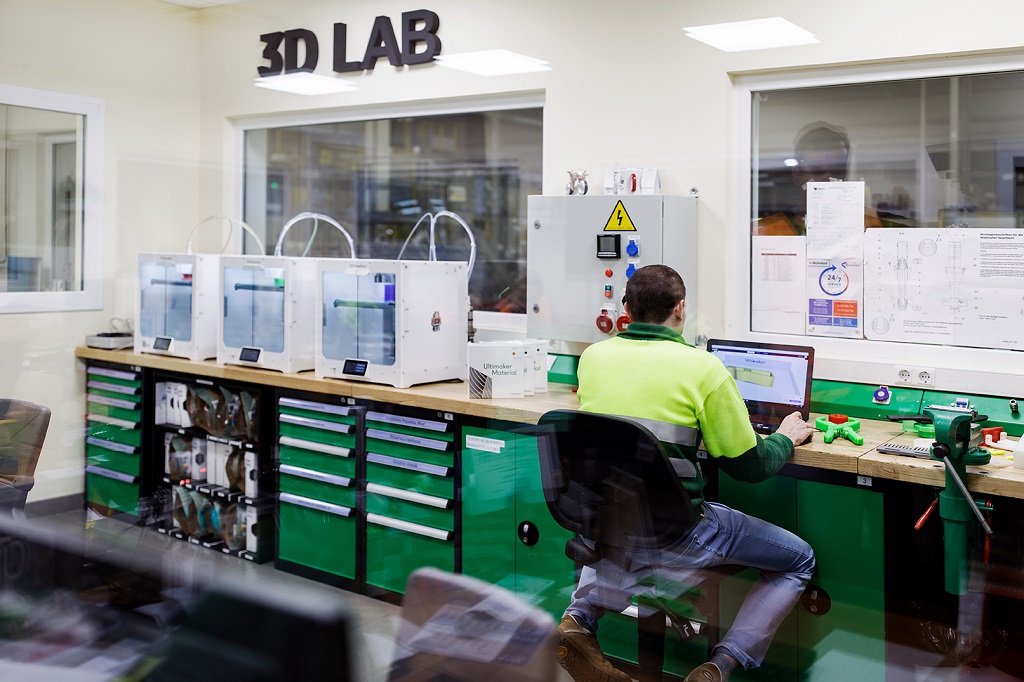![[Image: Ultimaker]](https://fabbaloo.com/wp-content/uploads/2020/05/4Ultimaker-Heineken3DLab_img_5eb0973e32aef.jpg)
3D printing tooling is something for beer company Heineken to toast.
Last year, Ultimaker introduced its S5 3D printer, and Heineken’s Seville, Spain brewery is among the users to bring it into operations. For about a year, the brewery has been using Ultimaker machines, starting with the Ultimaker 2+ and moving into several S5 units working away for safety devices, tooling, and on-demand parts.
These are all among the most common uses industry sees for desktop 3D printers, and it’s clear to see why: Heineken is reporting up to an 80% savings in production costs with 3D printed parts, as well as considerable increases to production uptime.
“We’re still in the first stages of 3D printing, but we’ve already seen a reduction of costs in the applications that we found by 70-90% and also a decrease of delivery time of these applications of 70-90%. Local manufacturing helps us a lot increasing uptime, efficiency and output. We use 3D printing to optimize the manufacturing line, create maintenance and quality control tools, and create tools for our machines which help us increase safety for our people. I think there will be even more purposes in the future,” said Isabelle Haenen, Global Supply Chain Procurement at Heineken.
Not having to outsource tooling and parts is a major benefit for busy production operations, and this brewery is certainly that — the location produces about 400 million liters of beer annually for several of Heineken’s brands.
As we often see, 3D printing was brought in with one specific usage in mind and, as the company gained experience and expertise, and eventually invested in more powerful equipment, their use adapted and grew.
The Heineken brewery started out with safety applications in mind. A year in, they now also create functional machine parts, made on demand for spare parts as these wear down. Keeping machinery running is critical in high-volume applications; time isn’t only money, it’s a lot of money, as any downtime is costly.
Redesigning parts is also streamlined, as 3D printing has allowed the team to optimize a quality sensor part; they report:
“The team was able to replace various redesigned parts with an optimized design. For example, a metal part used with the quality sensor on the conveyor belt would often knock bottles over, creating a blockage, or eject good bottles onto the ground. The redesigned 3D printed part prevents this, saving bottles, money, and time.”
Tools for quality control and maintenance have also been redesigned, and of course the initial safety-focused usage has remained a priority. 3D printed locking mechanisms keep machines from accidentally starting up again during maintenance, helping to prevent workplace injuries.
It seems sometimes that 3D printing and beer might not be the best mix; after all, the more we talk about industrialization, the less we talk about alcohol. Still, as every alcoholic drink manufacturer (and simple good judgement) remind us: drink responsibly. To allow its consumers to do that, it helps that breweries are increasingly manufacturing responsibly by bringing 3D printing into operations.
“Every company has its own unique challenges in the production process, which is why the ability to create custom solutions straight from the factory floor is such a game-changer for the manufacturing industry. Heineken is a prime example of a company that’s utilizing the Ultimaker S5 as an all-purpose manufacturing machine. We have enjoyed watching the use case evolve over the past year, from safety applications to the creation of fully functional parts for machines that lead to significant savings, and cannot wait to see what they come up with next,” said Jos Burger, CEO of Ultimaker.
Via Ultimaker











Healthcare 3D printing attempts to solve two problems that plague providing care: customization and cost.